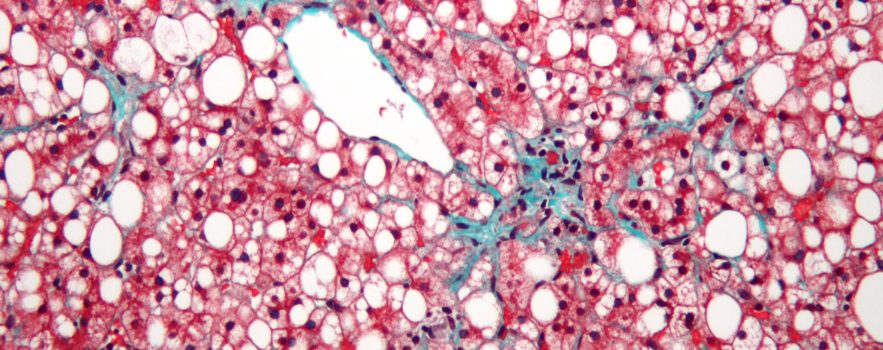The link between a specific genetic marker and severity of non-alcoholic fatty liver disease (NAFLD) has been validated in this study by researchers from several institutions and organisations, including the MRC Epidemiology Unit, Perspectum and UK Biobank. This will help to better identify individuals at increased risk of more advanced forms of the disease.
NAFLD is the accumulation of fat in the liver, which can lead to inflammation and scarring. The exact cause of NAFLD is unknown, but it almost always occurs alongside obesity and diabetes. NAFLD reportedly affects around one in four adults in the United States and Europe and by definition occurs in people who do not regularly drink excessive amounts of alcohol. Identifying genetic associations with NAFLD has important clinical implications; it can improve understanding of hepatic metabolism and facilitate the development of drug targets for NAFLD. However, this can be challenging because enormous amounts of data are needed to show that a specific genetic variant is linked to a particular disease or condition.
This latest research looked at the results of 42 different genetics studies, which included more than 1 million participants, and confirmed that a specific genetic variant (known as “rs641738C>T” near the gene “MBOAT7”) is positively associated with more advanced stages of NAFLD in individuals of European descent. This genetic variant is carried by about 40% of all people but this study suggests that it causes risk if the individual has two copies of the genetic mutation, which occurs in about 17% of people. The data collected for each participant comprised liver histology, blood tests and imaging markers of liver fat such as that measured by Perspectum’s LiverMultiScan®, IDEAL MRI-PDFF. These significant results prove that specific genetic factors contribute to an individual’s risk of developing NAFLD. It should be noted that this genetic association was found only in studies with individuals who self-identified as Caucasian. Moreover, the authors noted a substantial lack of genetics data from non-Caucasian populations, which is recognised as an issue within the field.
This study and its findings emphasise the power of collaborations and how access to huge quantities of accurate data, such the UK Biobank population and liver fat measured by LiverMultiScan, can help to identify genetic markers of liver disease. Together these will help to enhance understanding of the mechanisms behind NAFLD and find new ways to tackle this widespread disease. This research also demonstrates the utility of LiverMultiScan in large-scale population imaging with advantages of being fast, easy to do, not using radiation and not being prohibitively expensive.
Dr Jake Mann, senior author of the study and Visiting Clinical Fellow at the MRC Epidemiology Unit commented:
It is important to definitively establish which genes (and genetic variants) are (or are not) associated with specific conditions. This project required huge collaboration; without the contribution of scientists in many countries and institutions, we could not have reached these conclusions. Whilst the clinical applications of this work may be some time off, we hope these results will make a contribution to the science that underpins drug design and development.”
Reference
- Full paper: Teo K, Abeysekera KWM, Adams L, Aigner E, Anstee QM et al. rs641738C>T near MBOAT7 is associated with liver fat, ALT, and fibrosis in NAFLD: a meta-analysis. J Hepatol
(2020) S0168-8278(20)33598-4.
Featured image by By Nephron – Own work, CC BY-SA 3.0, https://commons.wikimedia.org/w/index.php?curid=7612867

 MRC Epidemiology Unit
MRC Epidemiology Unit